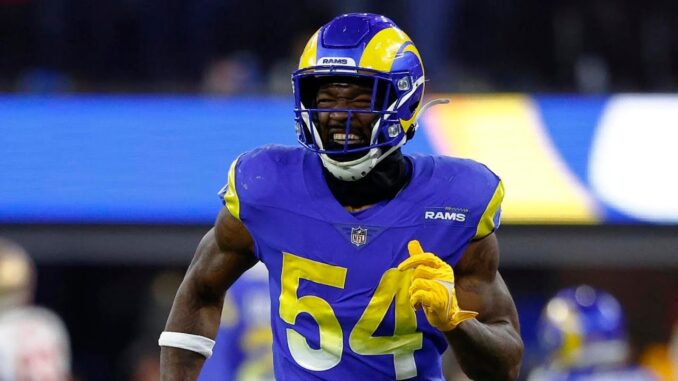
This weekend’s wildcard matchup between the Los Angeles Rams and the Detroit Lions will bring together two of the brightest offensive minds in all of football: Sean McVay for the Rams and offensive coordinator Ben Johnson for the Lions.
McVay has been head coach in Los Angeles since 2017 and is still the youngest amongst his ranks. Johnson is almost sure to get his opportunity this offseason, though reports indicate he’ll come with a hefty price tag.
What playoff tricks could Johnson have in store for the Rams? To me there is a glaring area in the Los Angeles defense that he could hone in on—and that’s middle linebacker Ernest Jones.
Jones is an important player for the Rams, don’t get me wrong. McVay also believes that because he held out his MLB this past weekend against the San Francisco 49ers along with other key starters like Matthew Stafford, Aaron Donald, Kyren Williams, and Cooper Kupp. Still, there is a major flaw inherent in Jones’ game and even his strengths may play into the Lions’ hands. Let’s get into it.
Where does Jones rank in terms of pass coverage?
The below chart compares NFL middle linebackers. The Y axis represents how often they are targeted. Players towards the bottom are targeted more often. The X axis displays the percentile ranking for separation allowed to receivers. Players allowing the most separation are on the left of the graphic. The separation metric accounts for routes run on plays even where the receiver is not targeted.
What does the chart tell us about Ernest Jones?
First, it’s clear that Jones is targeted at a rate less than the average NFL middle linebacker. Comparable players are Devin White of the Buccaneers, Jeremiah Owusu Koramoah of the Browns, and Zach Cunningham of the Eagles.
In terms of separation allowed, Jones ranks amongst the worst in the league. He’s next to oft-maligned players that struggle in coverage such as White, Ja’Whaun Bentley, and Quay Walker. On the opposite end of the spectrum is the gold standard of the position: Roquan Smith, Fred Warner, Demario Davis, and Blake Cashman.
A closer look at Jones’ PFF coverage grade (62.4, average) and tracking data show that he’s dropped into coverage 465 times this year (77.8% of passing plays). He’s been targeted 50 times and allowed 37 receptions (74.0% completion) for 319 yards—266 of those yards came after the catch. To Jones’ credit he has four pass breakups, a dropped interception, and has not allowed a touchdown as the closest defender.
The tracking data for the MLB position as a whole also paints an interesting picture as to what the Rams ask of Jones on a regular basis.
If we flash back to the earlier graphic we can recall that Logan Wilson, Jordan Hicks, and Devin White all ranked similar to Jones in terms of separation allowed. However, Wilson and Hicks have an average depth of target (ADOT) of 6.2 yards this season. White is at 5.7 yards. These figures rank highest in the NFL and fourth, respectively?
Where is Jones? He has an ADOT of 1.5 yards which is tied for the second-lowest mark in the NFL with the Jaguars Foyesade Oluokun. The lowest ADOT belongs to Owusu-Koramoah at 1.4 yards.
So even though Jones aligns similarly in the graphic to Wilson, White, and Hicks, it’s important to note that he is seemingly allowing the same degree of separation despite covering distances that are a quarter of the depth of the other linebackers.
Using Jones as a rusher also benefits Lions
The Rams have been successful at pressuring with Jones on interior rushes this season. Jones’ 33 pressures leads all middle linebackers according to PFF tracking, and his 22.2% rush percentage on passing reps is tied for ninth in the NFL.
But if you bring extra defenders against Johnson and Jared Goff, they are probably going to make you pay. That’s been the approach of Brian Flores and the Minnesota Vikings’ defense this season, and they did not find much success.
In two games the Vikings blitzed Goff on 85 of his attempts with 30 of those coming in the most recent Week 18 matchup. Overall Goff completed 43 of those passes for 493 yards, three touchdowns, and no interceptions.
Part of that success is the fact Detroit has one of the better offensive play callers in the NFL, an elite slot receiver in Amon-Ra St. Brown, a record-breaking rookie tight end in Sam LaPorta, and complementary running backs in Jahmyr Gibbs and David Montgomery. Gibbs gives the Lions easy completions out of the backfield and is liable to take any touch to the house. Montgomery is a capable receiver too and is dependable in pass protection (important against the blitz).
How will the Rams defense slow down Detroit?
Los Angeles must generate organic pressure from the interior with their best two players: Aaron Donald and rookie Kobie Turner. While OLB’s Byron Young and Michael Hoecht have flashed in moments, neither have been able to consistently create pressure. Goff could pick the Rams apart if they decide to bring extra defenders on the blitz, but Ernest Jones could also be a coverage liability in the middle of the defense against one of the best offensive schemes in football.
Will we see an offensive shootout this weekend in Detroit?

Leave a Reply